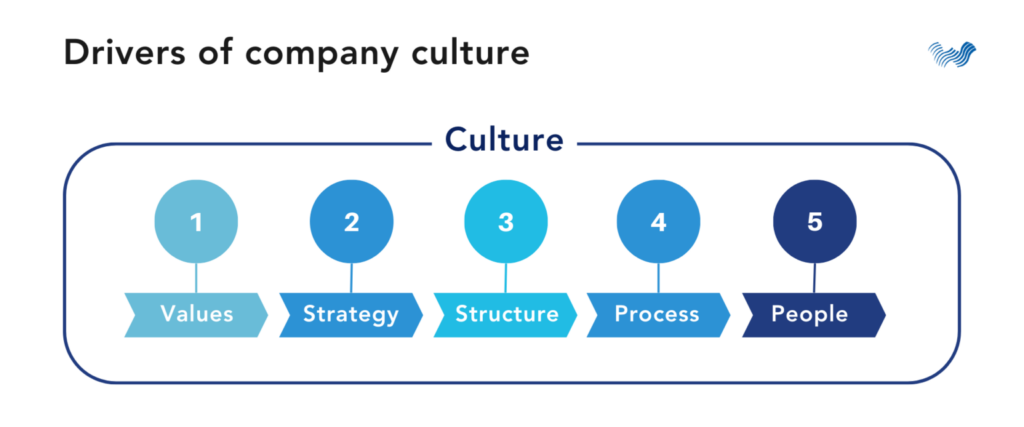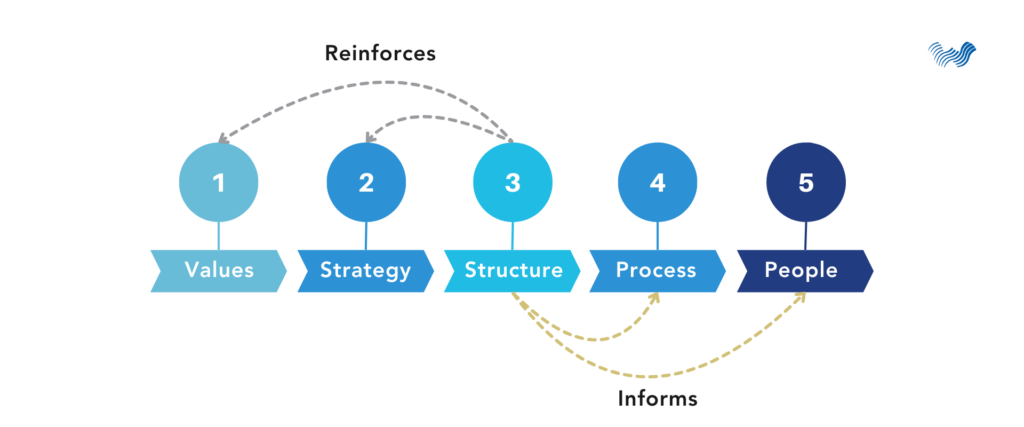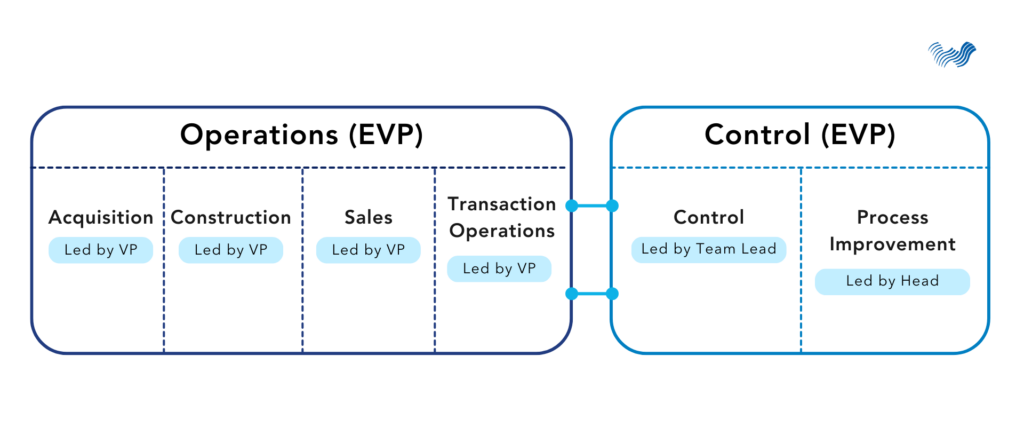In the previous articles of the Culture mini-series, we looked at how values and strategy impact an orgnisation’s culture. In this article, we explore organisational structure as a powerful driver of culture.
When our portfolio company Lhoopa, a digital real estate platform that enables the large-scale deployment of affordable homes, raised their pre-B bridge round last year, they knew that market demand and their strategy were not their biggest risks. They saw the health of their organisation as a critical factor that could make or break their success.
Lhoopa faced a number of organisational challenges, notably the lack of accountability within their teams, resulting in difficulties to execute. They struggled with hiring the right people and instilling the desired behaviours in their culture.
If you recall from the previous articles in the Culture mini-series, culture is the sum of the company’s values, strategy, structure, process, and people.

These elements are sequential. When designed intentionally, each element reinforces those before it and informs those after it. If not intentionally designed, organisational misalignment symptoms such as poor results, high friction and entropy, and disengaged employees surface.

Lhoopa had clarity in their vision, mission, and values. They had a clear strategic path towards meeting their goals and objectives. But it was quickly concluded that their organisational structure was not aligned with their Values and Strategy, leading to further misalignment in their Process and People.
With the help of a scaling coach, Lex Sisney of Organisational Physics, Lhoopa went on a journey to design an organisational structure to reinforce their Values & Strategy.
How Lhoopa used the structure levers
Before we delve into the specifics of Lhoopa’s example, let’s clarify what Organisational Structure is. First of all, it is not an organisational chart that shows reporting lines of individuals in the organisation. It is a system that outlines how certain activities are directed to achieve the organisation’s strategic mission.
Imagine a shopping mall designed to keep customers inside, spending as much as possible for as long as possible. It strategically places anchor stores to draw in target customers, positions restaurants and cafes to prolong visits, and arranges elevators to drive traffic throughout the mall. Similarly, your organisational structure should be intentionally designed to encourage employee behaviours that align with your strategy and goals.
Organisational structure establishes the foundation for decision making and information flow in the organisation. A well-designed structure focuses on key functions and accountability areas, rather than individual roles.
So if Structure is designed to support Strategy, does this mean that you have to change your structure every time your strategy changes? Yes, you absolutely must. Failure to do so means that even with the best strategy to differentiate yourself from your competitors, a misaligned structure will hinder your ability to execute that strategy.
The two main levers of an organisational structure are:
- The defined functions within the structure; and
- The location of each function in relation to other functions.
Let’s examine how Lhoopa used these two levers to achieve their desired change. Their unique differentiator involves decentralising the affordable housing value chain through a well-orchestrated process, unique technology, and a wide network of partners.
To ensure accountability, Lhoopa redesigned their structure so that each part of that value chain—acquisition, construction, property sales, and transaction operations—had its own function, led by a functional head. Each function is accountable for its relevant network group, such as construction managing the contractor network, and sales overseeing the agent network. This decentralisation enables each function to be responsive to its network’s needs. To facilitate smooth cross-functional collaboration, all four functions report to a senior leader accountable for the entire value chain.
Another key design element that Lhoopa adopted was separating the governance and control from the value chain. Given the critical role of the value chain to their success, Lhoopa introduced a new function accountable for control, audit, and check and balance of the operations value chain. This function also oversees a centralised network sub-function responsible for streamlined onboarding, compliance, and overall network health.

These design changes resulted from extensive learning, discussions, and the thoughtful application of organisational design principles. The outcomes included behavioural shifts among employees, prioritising operational excellence and displaying higher levels of accountability.
It’s important to note that there is no perfect organisational structure design. Trade-offs are inevitable. An organisation structure may optimise for speed at the expense of quality, or autonomy at the expense of control. The key is to determine the degree of optimisation or compromise for each polarity.
Designing your structure: key principles
Once you have clarity in your vision, mission, and values, and your strategy aligns with these, you are ready to design your structure. Approach the design with principles in mind. We highly recommend Lex Sisney’s Organisational Physics methodologies for its systems-thinking approach to design, enabling the execution of the strategic goals with as little friction as possible.
Regardless of the framework you use, you should first consider your business stage. For pre-product market-fit companies, a basic, lean, and flat structure optimises for agility. If you’ve found product-market fit, a functional structure works best as core functions become clearer. When you have sufficient traction in one market or product and are ready to expand into the next market or product, your structure may become more hybrid, combining functional and divisional structures.
Avoid designing your structure around people. Instead, start by mapping out your key processes with your strategy in mind. You may group similar activities within key processes into functions, ensuring functions are well-defined with clear measures of contribution to the overall strategy.
As part of your strategy, identify activities or groups of activities that differentiate you from your competitors and emphasise these in your structure design, similar to how Lhoopa highlighted parts of their value chain with separate functions.
HO CHI MINH CITY, VIETNAM, 9 APRIL 2024 – CNV, founded in 2020 by Nguyen Tuan Phu and Do Dang Khoa, is the leading cloud-based business and marketing solutions provider dedicated to offering digital transformation SaaS products and marketing growth services to assist MSMEs, SMEs, and enterprises in Vietnam achieve sustainable growth via marketing, loyalty and […]
Read moreSINGAPORE, 16 January 2024 – Customer data platform (CDP) Meiro has successfully secured US$3 million in an over-subscribed pre-Series A round, led by Southeast Asian VC firm Wavemaker Partners, with participation from angel investors at Singapore-based Angel Central. This marks Meiro’s first strategic funding round following five years of robust self-funded organic growth and profitability. The […]
Read morePrevious wins include eFishery’s Series C round in 2022 and Growsari’s Series B in 2021 MANILA & SINGAPORE, 27 SEPTEMBER 2024 – Wavemaker Partners, Southeast Asia’s leading venture capital firm investing in Enterprise, Deep Tech, and Sustainability startups, has won ‘VC Deal of the Year’ at the 32nd Annual Singapore Venture Capital & Private Equity Association (SVCA) […]
Read moreOnly structure your team down to individual roles once you have clearly defined and justified each function and how it connects to other functions.
Don’t get too complacent. As a high-growth startup, your strategies will evolve quickly, requiring your structure to evolve as well. The difference will be whether you do it intentionally to drive specific behaviours and outcomes like Lhoopa, or you let it evolve blindly, creating unwanted behaviours and results.
In our next article in our Culture mini-series, we will explore the next driver of Culture: Process. With an organisational structure that is designed with intention, you will then need to design your processes, practices and policies in alignment with your structure, strategy and values.






